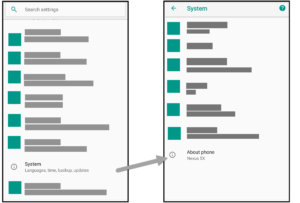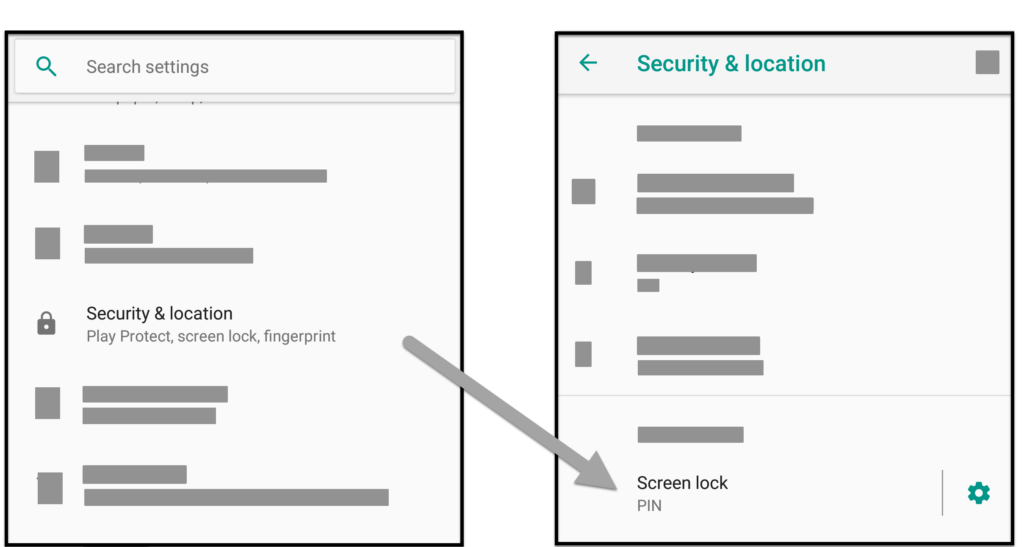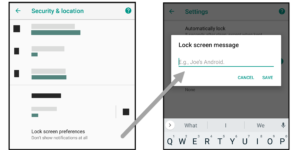![]()

This page represents Step One (of three)
from Mobile Security for Android Devices.
Secure your Android device by performing all of the following procedures:
- Secure Your Device Physically
- Document the Serial Number
- Lock Your Screen
- Add Contact to Lock Screen
- Add Timeouts to Screen Lock
- Add Antivirus Protection
- Update Apps Automatically
- Install System Updates
- Find My Device
NOTE: Only the first few sections include screenshots, which may not match your Android screen. Because procedures and screens vary by vendor device, Android OS version, and system updates, you might want to search your device or browser for the details of each procedure on occasion.
Secure Your Device Physically
To help prevent loss and theft:
- Engrave your name and email on the device. See the WOLF GUARD ID PROGRAM for free engraving services from campus police.
- Insert a business card or any form of contact information into the phone’s case.
- Keep devices hidden in motor vehicles.
- Never leave your device unattended in a non-secure location.
Document the Serial Number
Find the serial number for your device and document it in a safe and secure place.
NOTE: The IMEI (aka, International Mobile Equipment Identity) number is a unique set of 15 digits serving as each mobile device’s serial number.
To find the serial number for your device
Choose one or more of the following ways to perform this procedure:
![]() See the video.
See the video.
![]() Search the Settings: IMEI, serial number
Search the Settings: IMEI, serial number
![]() See the following procedure to navigate from Settings through the final screen.
See the following procedure to navigate from Settings through the final screen.
Settings > System > About phone > Status > IMEI Information
- Scroll or swipe to the Settings icon and tap it: In some cases, this requires opening Applications from the Home screen (possibly by swiping up) or by swiping down once or twice.

- System > About phone

- Status > IMEI information

- IMEI information (IMEI is the serial number)

- Document the serial number in a safe and secure place.
Lock Your Screen
If you leave your device unattended, anyone can access your data unless you lock it.
To lock your screen
Choose one or more of the following ways to perform this procedure:
![]() See the video.
See the video.
![]() Search the Settings: screen lock, lock
Search the Settings: screen lock, lock
![]() See the following procedure to navigate from Settings through the final screen.
See the following procedure to navigate from Settings through the final screen.
Settings > Lock Screen & Security > Screen Lock
- Open your device Settings.

- Lock Screen & Security > Screen Lock

Recommendations for Lock & PIN
- For minimum security, a 4-digit PIN is required. Instead, use a combination of letters and numbers for optimum security.
- Change this PIN at least once a year.
- Never enable Visible Passwords.
- Do not use Face Unlock as your only means of security.
Add Contact to Lock Screen
Now that your phone is locked with a secure password or PIN known only to you, add your backup contact information to the locked screen.
NOTE: Consider providing an alternate number or email address to reach you or a trustworthy friend.
To add contact information to your lock screen
Choose one or more of the following ways to perform this procedure:
![]() See the video.
See the video.
![]() Search the Settings: lock screen, lock screen message
Search the Settings: lock screen, lock screen message
![]() See the following procedure.
See the following procedure.
Settings > Security & location > Lock screen preferences> Lock screen message
- Open your device Settings.
- Security & location > Screen lock > Lock screen message

- Type your message.
For example: “Owner is Ren B. Call 555-555-5555 or email unityID@ncsu.edu”
Add Timeouts to Screen Lock
To set timeout periods
- Set the length of time it takes for your screen to turn off when not in use:
![]() See the video.
See the video.
![]() Search the Settings: screen timeout, timeout, lock
Search the Settings: screen timeout, timeout, lock
![]() Settings > Display > Advanced > Screen timeout
Settings > Display > Advanced > Screen timeout
- Set the length of time it takes for the passcode to be required after the display turns off:
![]() See the video.
See the video.
![]() Search the Settings: lock, automatically lock
Search the Settings: lock, automatically lock
![]() Settings > Lock Screen > Automatically lock
Settings > Lock Screen > Automatically lock
Add Antivirus Protection
Install antivirus software on your device.
![]() CAUTION: Always keep antivirus software up-to-date! This is absolutely key to protecting your mobile devices. New attacks emerge constantly, so if your antivirus software is not up-to-date as soon as the latest software update is released, you are putting yourself and the Pack at risk.
CAUTION: Always keep antivirus software up-to-date! This is absolutely key to protecting your mobile devices. New attacks emerge constantly, so if your antivirus software is not up-to-date as soon as the latest software update is released, you are putting yourself and the Pack at risk.
To add antivirus protection
See this independently tested Android Antivirus Report to select the best antivirus software and install it as instructed.
Update Apps Automatically
Apps need to be updated frequently to fix cybersecurity gaps and vulnerabilities.
![]() CAUTIONS:
CAUTIONS:
- Use only vendor-supported versions of any installed applications.
- Remove applications you are no longer using.
To update apps automatically
Choose one or more of the following ways to perform this procedure:
![]() See the video.
See the video.
![]() Search the Settings: auto-update, update, apps
Search the Settings: auto-update, update, apps
![]() Google Play > Settings > Auto-update apps
Google Play > Settings > Auto-update apps
NOTE: When an app updates to a version that changes access permissions to your device, you will have to approve the update manually.
Install System Updates
Check for system updates automatically. Each carrier (AT&T, Verizon, Sprint, and so forth) may have different policies and procedures for initiating system updates. System updates include software patches for known cybersecurity gaps and vulnerabilities and should be installed as soon as they are released.
![]() CAUTION: Use only vendor-supported versions of your operating system.
CAUTION: Use only vendor-supported versions of your operating system.
To check for system updates
Choose one or more of the following ways to perform this procedure:
![]() See the video.
See the video.
![]() Search the Settings: system updates, system update, check for update
Search the Settings: system updates, system update, check for update
![]() Navigate: Settings > System Update
Navigate: Settings > System Update
Find My Device
Find My Device will locate, ring, and remotely erase a device as long as it has data connectivity.
Use Find My Device (formerly Android Device Manager) with your personal or NC State Google account to perform device tasks remotely (locate, ring, lock, wipe, and so forth).
To turn on Find My Device
Choose one or more of the following ways to perform this procedure:
![]() See the video.
See the video.
![]() Search the Settings: system updates, system update, check for update
Search the Settings: system updates, system update, check for update
![]() Navigate and tap: Settings > System Update > Google > Security > Find My Device
Navigate and tap: Settings > System Update > Google > Security > Find My Device
NOTE: If you have any questions or concerns about this procedure, ask your IT group for assistance.
Lost or Stolen
If Find My Device was unsuccessful and you are concerned your phone might not be recoverable:
- Report loss or theft of your mobile device (regardless of ownership) to your department and wireless carrier (if applicable).
- Report lost or theft of NC State property immediately to Campus Police and complete/submit the State Property Incident Report.
- Immediately change any passwords saved on the device unless they are stored in a secure password manager.
Next Step
After completing all procedures from this page, continue with Securing Your Android Data or return to Mobile Security for Android Devices.

